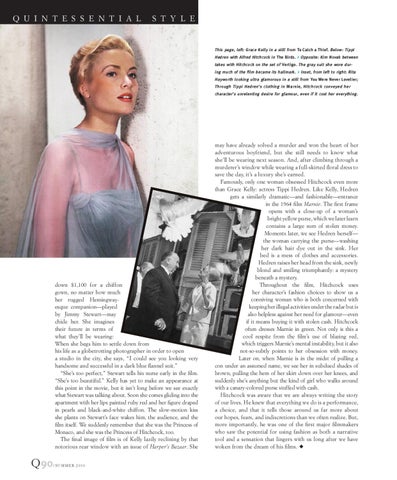Q U I N T E S S E N T I A L
S T Y L E
This page, left: Grace Kelly in a still from To Catch a Thief. Below: Tippi Hedren with Alfred Hitchcock in The Birds. > Opposite: Kim Novak between takes with Hitchcock on the set of Vertigo. The gray suit she wore during much of the film became its hallmark. > Inset, from left to right: Rita Hayworth looking ultra glamorous in a still from You Were Never Lovelier; Through Tippi Hedren’s clothing in Marnie, Hitchcock conveyed her character’s unrelenting desire for glamour, even if it cost her everything.
down $1,100 for a chiffon gown, no matter how much her rugged Hemingwayesque companion—played by Jimmy Stewart—may chide her. She imagines their future in terms of what they’ll be wearing: When she begs him to settle down from his life as a globetrotting photographer in order to open a studio in the city, she says, “I could see you looking very handsome and successful in a dark blue flannel suit.” “She’s too perfect,” Stewart tells his nurse early in the film. “She’s too beautiful.” Kelly has yet to make an appearance at this point in the movie, but it isn’t long before we see exactly what Stewart was talking about. Soon she comes gliding into the apartment with her lips painted ruby red and her figure draped in pearls and black-and-white chiffon. The slow-motion kiss she plants on Stewart’s face wakes him, the audience, and the film itself. We suddenly remember that she was the Princess of Monaco, and she was the Princess of Hitchcock, too. The final image of film is of Kelly lazily reclining by that notorious rear window with an issue of Harper’s Bazaar. She
Q90
/ SUMMER 2010
may have already solved a murder and won the heart of her adventurous boyfriend, but she still needs to know what she’ll be wearing next season. And, after climbing through a murderer’s window while wearing a full-skirted floral dress to save the day, it’s a luxury she’s earned. Famously, only one woman obsessed Hitchcock even more than Grace Kelly: actress Tippi Hedren. Like Kelly, Hedren gets a similarly dramatic—and fashionable—entrance in the 1964 film Marnie. The first frame opens with a close-up of a woman’s bright yellow purse, which we later learn contains a large sum of stolen money. Moments later, we see Hedren herself— the woman carrying the purse—washing her dark hair dye out in the sink. Her bed is a mess of clothes and accessories. Hedren raises her head from the sink, newly blond and smiling triumphantly: a mystery beneath a mystery. Throughout the film, Hitchcock uses her character’s fashion choices to show us a conniving woman who is both concerned with keeping her illegal activities under the radar but is also helpless against her need for glamour—even if it means buying it with stolen cash. Hitchcock often dresses Marnie in green. Not only is this a cool respite from the film’s use of blazing red, which triggers Marnie’s mental instability, but it also not-so-subtly points to her obsession with money. Later on, when Marnie is in the midst of pulling a con under an assumed name, we see her in subdued shades of brown, pulling the hem of her skirt down over her knees, and suddenly she’s anything but the kind of girl who walks around with a canary-colored purse stuffed with cash. Hitchcock was aware that we are always writing the story of our lives. He knew that everything we do is a performance, a choice, and that it tells those around us far more about our hopes, fears, and indiscretions than we often realize. But, more importantly, he was one of the first major filmmakers who saw the potential for using fashion as both a narrative tool and a sensation that lingers with us long after we have woken from the dream of his films. u
